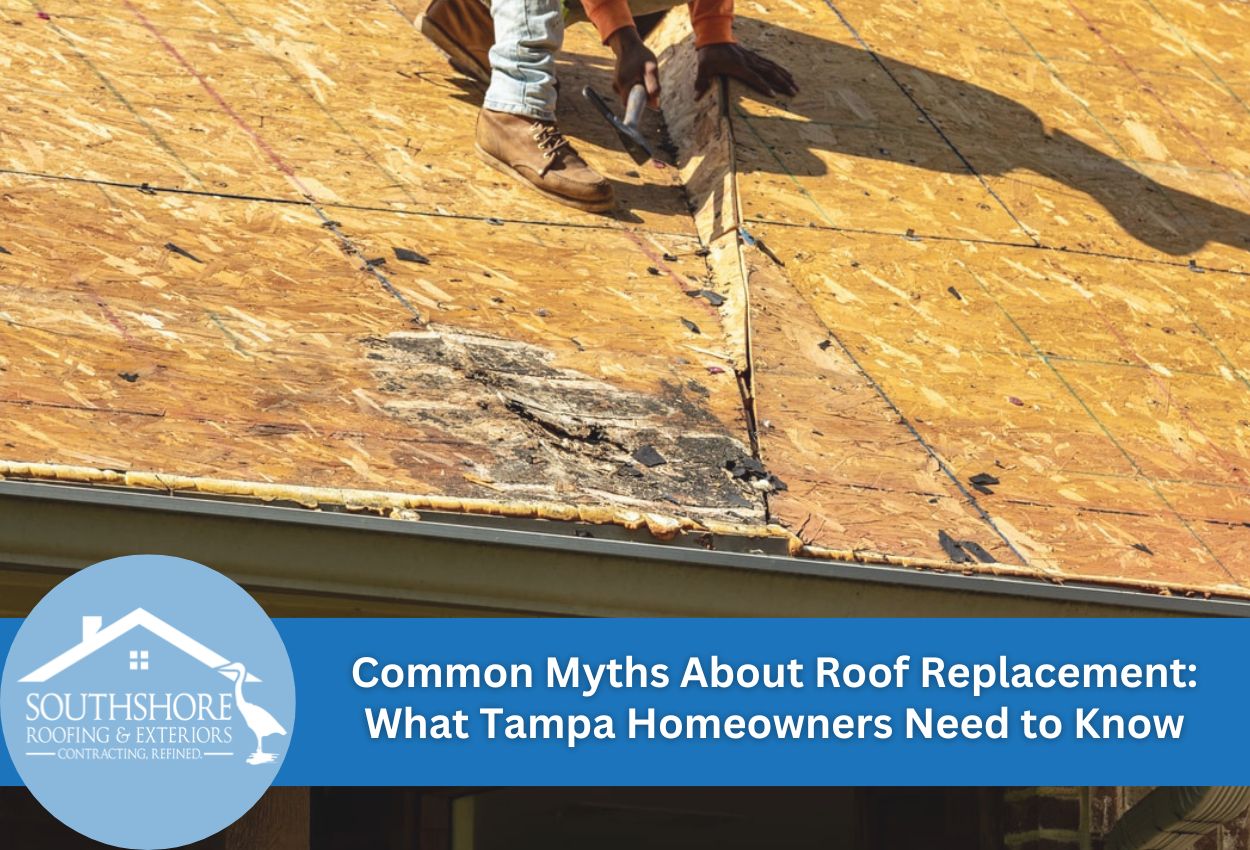When severe weather strikes Tampa, the durability of your roof becomes a critical defense for your home. Unfortunately, many homeowners base important roofing decisions on widespread misconceptions rather than facts. These roof replacement myths lead to poor choices, unnecessary expenses, and home protection that’s extremely vulnerable to Florida’s hurricane season and year-round extreme weather.
By debunking common roofing myths, homeowners can better navigate the sometimes complicated process of roof replacement. Separating roof replacement facts from fiction helps ensure your investment provides the protection your Tampa home needs. Before making any decisions about your roof, it’s important to understand what’s actually true and what’s simply conventional wisdom that doesn’t hold up to scrutiny. The following information will help clarify these misconceptions and provide the accurate guidance needed for roof replacement success.
“All Roofers Are the Same” Myth: Choosing the Right Tampa Professional
The belief that all roofing contractors offer equivalent expertise and service is a dangerous misconception for Tampa homeowners. In reality, roofing professionals vary dramatically in their qualifications, specialization, and knowledge of local requirements. Florida’s building codes are among some of the strictest in the nation due to the tendency for hurricanes to develop, and not every roofer has the specialized knowledge to install roofs that meet these standards.
Experience matters significantly when selecting a roofing contractor. The unique challenges that Tampa faces, from intense UV exposure to heavy seasonal rains and hurricane-force winds, require specific installation techniques and material selections. Established local contractors understand which roofing systems perform best under these conditions and how to install them for maximum durability.
When vetting potential roofing professionals, Tampa homeowners should verify several key credentials. Look for proper licensing, comprehensive insurance coverage, and manufacturer certifications that indicate specialized training. Check multiple review sources and ask for local references, particularly from neighborhoods with similar exposure to yours. Pay special attention to how contractors explain warranty options as well, since quality professionals will offer clear documentation on both manufacturer and workmanship warranties.
The difference between an average roofer and a qualified Tampa roofing professional often becomes apparent years after the original installation took place, and you’re faced with your first major storm challenge. Investing time in proper contractor selection helps ensure your roof replacement truly protects your home against Florida’s weather extremes.
The Price Myth: The Lowest Price is The Best
When Tampa homeowners receive multiple quotes for roof replacement, the temptation to select the lowest bid can be strong. However, this common approach often leads to significant problems down the road, especially in Florida’s challenging climate. What may appear as initial savings frequently turns into early deterioration, leaks, and even complete roof failure during severe weather events.
Quality roofing materials and proper installation techniques come at a cost that cheaper quotes typically can’t support. With Florida’s intense UV exposure, heavy rains, and hurricane conditions, cutting corners on materials or workmanship can dramatically reduce a roof’s lifespan. A properly installed roof using quality materials might cost more initially, but it can last 15 to 20 years longer than budget alternatives.
When evaluating roof replacement quotes, Tampa homeowners should consider several critical factors beyond the bottom-line price. These include material grade and warranty coverage, installation methods designed for high-wind resistance, proper ventilation systems, and enhanced water barrier protection. Reputable roofing contractors will itemize these elements in their quotes, demonstrating transparency about what you’re actually paying for.
The true value of a roof replacement lies in its long-term performance under Florida’s extreme conditions. By focusing on quality over initial price, homeowners are not only able to protect their roofs, but also everything beneath them. Remember that proper roof installation is less about finding bargains and more about securing lasting protection for your Tampa home.
Material Myths: What Works Best for Tampa Homes
Many Tampa homeowners fall prey to misconceptions about which roofing materials are best suited for Florida’s unique weather. One persistent myth suggests that all roofing materials perform equally in our region’s heat, humidity, and frequent storms. In reality, the choice of material directly impacts both the performance and longevity in Tampa’s harsh conditions.
Metal roofs, often overlooked due to misconceptions about noise and cost, actually offer exceptional longevity and hurricane resistance, all of which are critical features for Tampa homes. Meanwhile, tile roofs provide excellent heat reflection but require proper structural support. Asphalt shingles, while popular and cost-effective, vary dramatically in quality and storm resistance depending on their rating and installation.
Another common misconception involves energy efficiency. Many homeowners don’t realize that roofing material directly impacts cooling costs, which is a significant consideration in Tampa’s year-round heat. Light-colored or specially coated “cool roof” materials can reduce attic temperatures by up to 50 degrees and cut cooling costs by 15% to 25% compared to standard dark shingles.
The choice of material also directly affects the home’s value. While premium materials increase initial investment, they typically yield higher returns during resale, particularly in hurricane-prone regions where buyers increasingly prioritize storm resistance. Understanding these material-specific benefits helps homeowners make decisions based on Tampa’s specific climate challenges rather than general roofing advice that might work elsewhere but falls short in Florida’s extreme conditions.
DIY Myths: When Professional Installation Matters
The rise of home improvement shows and online tutorials has led many Tampa homeowners to believe that roof installation or replacement can be a successful DIY project. This dangerous misconception puts both personal safety and property at risk, especially in Florida, where roofs must withstand extreme weather conditions. What might seem like a money-saving decision can quickly become expensive when improper installation leads to water damage, structural issues, or roof failure during a hurricane.
Florida’s building codes require specific features to reduce the impact of hurricanes on the home, features that DIYers may miss because they simply don’t know about them. Using the proper hurricane straps, correct nail patterns, and specialized flashing techniques is critical, and while professional roofers understand this, it’s something that DIYers frequently overlook. Even small errors in waterproofing can lead to devastating mold problems in Tampa’s humid climate, potentially causing thousands in remediation costs.
While homeowners can safely handle some roof maintenance tasks like cleaning gutters or visual inspections, certain situations always demand professional expertise. These include structural repairs, reinforcement, installing new roofing systems, and addressing water intrusion issues. A qualified Tampa roofing contractor will ensure all the work done complies with local building codes, manufacturer specifications, and insurance requirements.
Remember that improper installation not only risks personal safety but may also void material warranties and complicate insurance claims after storms. The knowledge required for proper roof installation in Florida makes this one home improvement project where professional expertise isn’t just helpful — it’s essential for long-term protection and compliance.
Timing and Seasonal Myths: When to Replace Your Roof in Tampa
A persistent myth among Tampa homeowners involves timing roof replacements according to seasons. Many believe summer months should be avoided due to rain, while others rush replacements just before hurricane season begins. The reality is more nuanced than these guidelines suggest, and understanding the truth helps homeowners make better-informed decisions.
While Tampa’s rainy season does present certain challenges, professional roofers work year-round and have strategies to protect your home during installation regardless of the weather patterns. Quality contractors monitor forecasts carefully, use protective tarping, and schedule work accordingly. In fact, scheduling during traditionally “off-peak” seasons sometimes offers advantages like better contractor availability and potentially more competitive pricing.
Another timing misconception involves waiting for obvious damage before considering replacement. Savvy Tampa homeowners recognize that certain subtle signs warrant professional inspection: shingles losing granules, slight sagging, or increased energy bills can indicate a roof nearing the end of its service life. Addressing these early warning signs often prevents more expensive interior damage that occurs when replacement is delayed too long.
The best approach isn’t about following random seasonal rules, but rather understanding your roof’s current condition through professional inspection. Most Tampa roofing experts recommend annual evaluations, with additional checks after significant storms. This proactive approach ensures replacement happens when truly necessary, not based on misconceptions about “perfect” timing that might leave your home vulnerable during Florida’s unpredictable weather patterns.
Permit and Insurance Facts vs. Fiction
Navigating the world of building permits and insurance requirements for roof replacements in Tampa can be confusing. Many homeowners operate under misconceptions that can lead to expensive mistakes and compliance issues. Understanding the facts about permits isn’t just about following rules — it’s about protecting your investment and ensuring your home remains properly insured.
Contrary to popular belief, most roof replacements in Tampa require permits, regardless of whether you’re simply replacing existing materials. The permit process isn’t just bureaucratic red tape; it ensures your new roof meets Florida’s strict standards for hurricane resistance. Skipping permits may save you time initially, but it can create significant problems when you try to sell your home or file an insurance claim, which is when unpermitted work tends to be discovered.
On the insurance front, many Tampa homeowners mistakenly believe a new roof automatically lowers insurance premiums. While a roof replacement often positively impacts your price of coverage, the relationship is complex. Insurance companies evaluate the roof’s age, material, and installation quality before making a decision on your new premium, with many requiring specific wind reduction features and formal inspection reports before it changes.
Another common misconception involves notification requirements. Most insurance policies require homeowners to inform their carrier about major home improvements, including roof replacements. Failure to provide proper documentation can complicate future claims, especially after storm damage.
Ensure Your Roof is Hurricane-Ready with SouthShore Roofing & Exteriors
Understanding the truth behind common myths about roof replacements is crucial, especially in Tampa’s harsh weather conditions. Not all roofers can offer the same quality and knowledge of local building codes and hurricane requirements, but luckily, SouthShore Roofing & Exteriors specializes in providing top-tier materials and installation that stand up to Florida’s climate.
Choosing the right materials and professionals dramatically affects the longevity and effectiveness of your roof. Don’t let misconceptions guide your decisions; call SouthShore Roofing & Exteriors today at (813) 400-3329 to discuss your roofing needs and ensure your home is protected with the best solutions available in Tampa.







